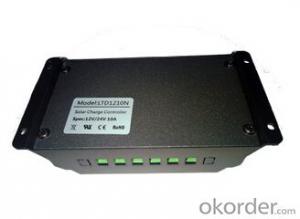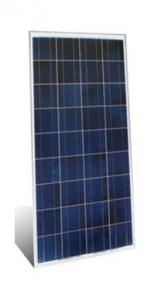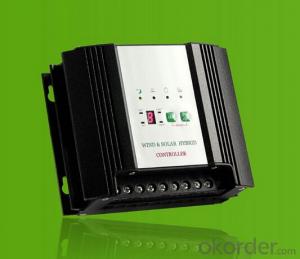BYGD Solar Charger Controller Model SC2024S for Streetlight system
- Loading Port:
- Shanghai
- Payment Terms:
- TT OR LC
- Min Order Qty:
- 10 unit
- Supply Capability:
- 50 unit/month
OKorder Service Pledge
OKorder Financial Service
You Might Also Like
Details of products:
product model: SC2024S 20A
External Size:133mm×70mm
Mounting hole Size:126mm×50mm
Performance
12V/24V automatical adaption, control and set button changed into tact key, larger contact terminal can offer wire of 6 m2
◆ double LED digital display, clear for observation
◆ recharging mode by three phases
◆ PWM pulse modulated recharging technology
◆set light-dependent control and 1-13hous time control
◆short circuit protection, overvoltage protection, overcurrent protection and lighting protection
◆standy current no more than 5mA
example
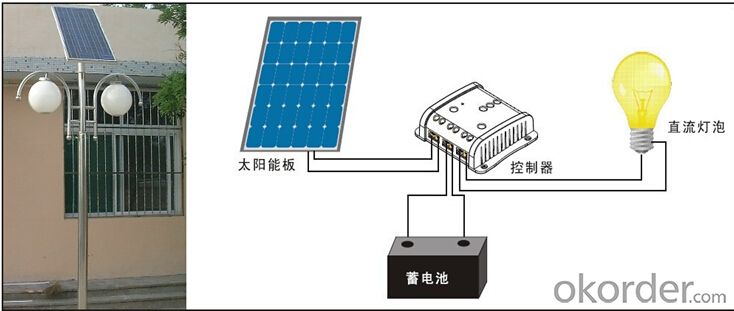
Technical characteristics
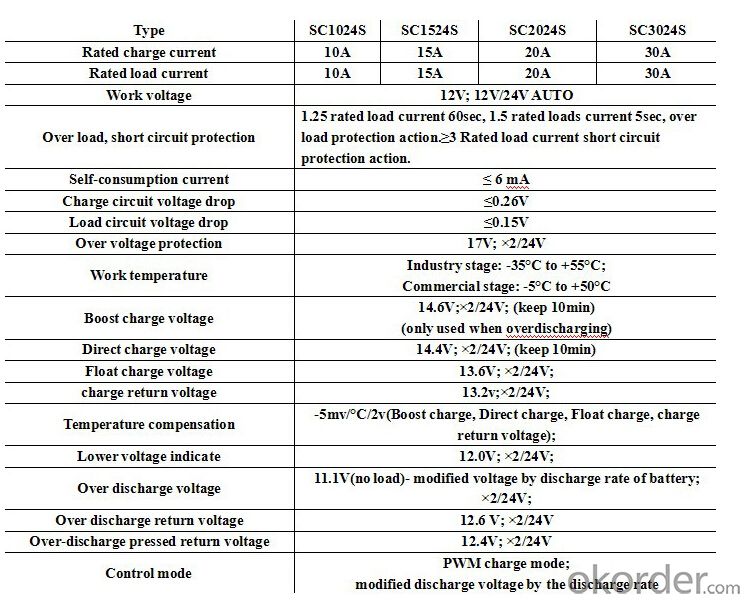
P.S.: This product is manufactured by order, so please call us for more info and service
- Q:Can a solar controller be used with solar panels that are mounted on a moving vehicle?
- Solar panels that are mounted on a moving vehicle can indeed be used with a solar controller. The purpose of a solar controller is to regulate the charging of batteries from solar panels, no matter the application or location. Even when the solar panels are on a moving vehicle, the solar controller will continue to carry out its functions effectively. It will constantly monitor the voltage and current from the solar panels and adjust the charging process accordingly to ensure that the batteries are optimally charged. Additionally, the solar controller will provide vital protection against overcharging or discharging of the batteries, which is crucial for maintaining their longevity and performance. Therefore, it is highly recommended to utilize a solar controller when using solar panels on a moving vehicle to ensure the efficient and safe operation of the solar power system.
- Q:What are the main components of a solar controller?
- Solar controllers consist of a charge controller, a battery monitor, and a temperature sensor as their primary components. The charge controller's role is to regulate the voltage and current from the solar panels, ensuring the batteries are charged efficiently and safely. It prevents the batteries from overcharging or over-discharging, which can cause damage and reduce their lifespan. Modern charge controllers often incorporate maximum power point tracking (MPPT) technology, which continuously adjusts the voltage and current to match the batteries' requirements, optimizing the power output from the solar panels. The battery monitor is used to measure and display the state of charge (SOC) and voltage of the batteries. This information is vital for users to determine the remaining capacity of their batteries and estimate how long they can power their devices or systems. Advanced battery monitors may also provide additional data such as battery temperature, aiding in the effective management of the charging process. The temperature sensor is employed to monitor the temperature of the batteries. Elevated temperatures can adversely affect battery performance and lifespan. By using the temperature sensor, the solar controller can adjust the charging parameters based on the battery temperature, ensuring optimal charging and protection from excessive heat. In addition to these primary components, some solar controllers may offer features like LCD displays for convenient monitoring, USB ports for charging small electronic devices, and communication ports for data logging or remote monitoring. The specific components and features of a solar controller can vary depending on the model and manufacturer, but the charge controller, battery monitor, and temperature sensor are essential components that guarantee the efficient and safe operation of solar systems.
- Q:How do PWM solar controllers work?
- PWM (Pulse Width Modulation) solar controllers regulate the charging of batteries in solar power systems. They work by rapidly switching the solar panel's output on and off, creating a pulsating current that is then smoothed out and regulated to charge the batteries efficiently. This method ensures that the batteries are charged at an optimal rate, preventing overcharging and extending their lifespan.
- Q:What is a solar controller and what is its purpose?
- A solar controller, or charge controller, is a device used to regulate the flow of electricity between a solar panel and a battery or load. Its purpose is to prevent overcharging of the battery, protect against reverse current flow, and optimize the charging process for maximum efficiency and battery life.
- Q:Can a solar controller handle different battery types (e.g., lead-acid, lithium)?
- Yes, a solar controller can handle different battery types such as lead-acid and lithium. Many modern solar controllers are designed to be compatible with various battery chemistries and provide appropriate charging profiles based on the specific battery type. This ensures optimal charging and protection for the batteries, regardless of whether they are lead-acid or lithium.
- Q:How does a solar controller regulate the charging of batteries?
- A solar controller regulates the charging of batteries by continuously monitoring the voltage and current levels from the solar panels. It ensures that the batteries are charged at the optimal voltage and current, preventing overcharging or undercharging. The solar controller intelligently adjusts the charge rate based on the battery's state of charge, temperature, and other factors, maximizing the efficiency and lifespan of the batteries.
- Q:Can a solar controller be used with a solar-powered recreational facility?
- Yes, a solar controller can be used with a solar-powered recreational facility. A solar controller is an essential component that regulates the power flow from the solar panels to ensure optimal charging and protection of the batteries. It helps maintain the proper voltage and current levels, preventing overcharging and extending the lifespan of the batteries. Therefore, it is crucial to have a solar controller in place to efficiently manage the energy generation and storage of a solar-powered recreational facility.
- Q:How does a solar controller prevent battery discharge during nighttime?
- A solar controller prevents battery discharge during nighttime by automatically detecting the absence of sunlight and disconnecting the battery from the solar panel. This prevents any reverse current flow from the battery back into the solar panel, ensuring that the battery remains fully charged and protected from draining during the night.
- Q:What is the role of a load control function in a solar controller?
- The role of a load control function in a solar controller is to manage and regulate the power supply to the connected loads or appliances in a solar power system. It ensures that the loads receive the appropriate amount of power and prevents overloading or damaging the system. The load control function helps optimize energy usage and improve the overall efficiency and reliability of the solar controller.
- Q:How can I determine the size of solar controller I need for my system?
- To determine the size of the solar controller you need for your system, you should consider two main factors: the maximum current and voltage of your solar panels. First, calculate the maximum current your panels produce by dividing the wattage rating by the voltage rating. Then, choose a solar controller that can handle this maximum current and voltage. It's always recommended to select a controller with a slightly higher capacity to allow for potential future expansions or efficiency losses.
1. Manufacturer Overview |
|
|---|---|
| Location | |
| Year Established | |
| Annual Output Value | |
| Main Markets | |
| Company Certifications | |
2. Manufacturer Certificates |
|
|---|---|
| a) Certification Name | |
| Range | |
| Reference | |
| Validity Period | |
3. Manufacturer Capability |
|
|---|---|
| a)Trade Capacity | |
| Nearest Port | |
| Export Percentage | |
| No.of Employees in Trade Department | |
| Language Spoken: | |
| b)Factory Information | |
| Factory Size: | |
| No. of Production Lines | |
| Contract Manufacturing | |
| Product Price Range | |
Send your message to us
BYGD Solar Charger Controller Model SC2024S for Streetlight system
- Loading Port:
- Shanghai
- Payment Terms:
- TT OR LC
- Min Order Qty:
- 10 unit
- Supply Capability:
- 50 unit/month
OKorder Service Pledge
OKorder Financial Service
Similar products
New products
Hot products
Hot Searches
Related keywords

